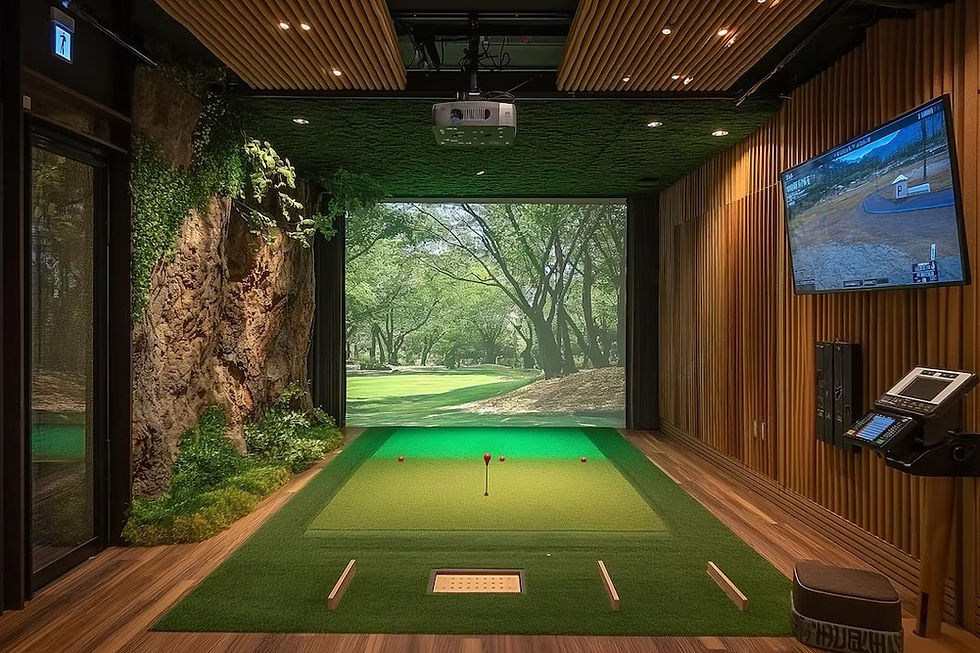How to Plan & Build a Golf Simulator Room at Home in Arizona
- Customer Support
- Oct 13
- 3 min read
Updated: Oct 15

Creating a golf simulator room at home in Arizona has become increasingly popular. With the right planning, homeowners can enjoy year-round practice without worrying about extreme heat or seasonal challenges. This guide covers how to plan and build an indoor golf simulator tailored to your space and lifestyle.
Why an At Home Golf Simulator is Perfect for Arizona Living
Building an at home golf simulator offers Arizona homeowners a convenient way to play and practice golf regardless of weather conditions. From escaping summer heat to improving your game, the benefits are clear.
Benefits of Having an Indoor Golf Simulator
Installing an indoor golf simulator lets you practice anytime, improve your swing, and play courses from around the world. It’s also an investment in entertainment and lifestyle, offering friends and family an exciting experience at home.
Overcoming Arizona’s Climate Challenges
Arizona’s hot summers and dry climate can limit outdoor play. An indoor setup ensures you never miss practice due to extreme temperatures. This makes a golf simulator an ideal choice for local homeowners.
Choosing the Right Space for Your Golf Simulator
Selecting the right location is critical for a successful installation. The space must allow for full swings, comfortable movement, and the integration of necessary technology.
Room Size Requirements: Most simulators require at least 12 feet wide, 18 feet deep, and 10 feet high. This ensures there’s enough clearance for both right- and left-handed players, as well as space for screens and equipment.
Ceiling Height Considerations: Ceiling height is often overlooked but essential. A minimum of 9-10 feet is recommended to prevent damage and ensure safe swings. Taller ceilings offer more flexibility for advanced systems.
Garage, Basement, or Spare Room Options: Popular choices for simulator rooms include garages, basements, and spare bedrooms. Each offers unique benefits. Garages provide ample space, basements offer sound insulation, and spare rooms are convenient for everyday use.
Essential Components of a Golf Simulator Setup
A golf simulator relies on several key elements. Choosing high-quality components ensures accuracy, immersion, and long-term value.
Launch Monitors and Screens: The launch monitor is the heart of your simulator, capturing ball data and swing metrics. Pair this with a durable impact screen designed to handle repeated ball strikes for the best results.
Projectors and Display Options: High-resolution projectors create realistic visuals. Consider brightness and throw distance to match your room dimensions. Some setups also integrate flat-screen displays for added versatility.
Hitting Mats and Flooring: Quality hitting mats protect joints and simulate realistic turf conditions. Flooring options like padded turf or interlocking foam add comfort, reduce noise, and create a polished look.
Designing for Comfort and Performance
Beyond technology, comfort plays a major role in the simulator experience. Lighting, climate, and acoustics all contribute to the quality of play.
Lighting & Acoustics for Realistic Play
Proper lighting prevents shadows and enhances projector visuals. Acoustic treatments reduce noise, creating a quieter environment. Soundproofing is especially valuable in Arizona homes with open layouts.
Climate Control in Arizona Homes
Climate control is essential in Arizona. Insulating walls, adding air conditioning, or using portable cooling systems keeps your space comfortable year-round. This ensures extended play sessions without discomfort.
Seating and Multi-Use Design Ideas
Consider adding seating for spectators, friends, or family. Multi-use designs allow the room to double as a media or gaming space. Comfortable furniture enhances both function and enjoyment.
Common Mistakes to Avoid When Building a Simulator Room
When planning your golf simulator, avoid common pitfalls that can affect performance and enjoyment. These include:
Choosing a room with ceilings too low
Underestimating lighting needs
Using cheap mats that damage clubs
Ignoring soundproofing in shared spaces
Skipping professional setup for key components
Premier Golf Sims: Arizona’s Trusted Golf Simulator Experts
We are Arizona and Southern California's premier authorized TrackMan and Golfzon dealers and installers, specializing in high-performance golf simulators and fully integrated mixed media rooms.
With decades of combined experience in system design, audio video, smart home integration, and luxury construction, we create immersive entertainment environments tailored to how you live, work, and play.
Whether it’s transforming a garage into a golfer’s retreat or equipping a new-build community with tech-forward amenities, we bring your vision to life with precision and passion.
Frequently Asked Questions (FAQs)
1. How much space do you need for a golf simulator at home?
Most setups need about 12 feet wide, 18 feet deep, and 10 feet high. Larger rooms offer more flexibility.
2. Can you install a golf simulator in your garage in Arizona?
Yes, garages are popular choices. Adding insulation and climate control improves comfort during hot summers.
3. What is the average cost of an indoor golf simulator?
Costs vary depending on equipment quality, installation, and customization.
4. Do you need professional installation?
Yes, professional installation ensures accuracy, proper calibration, and long-term reliability.
5. Will a golf simulator increase your home’s value?
A well-designed simulator room can add appeal and value, especially in Arizona’s luxury housing market.



